The Unexpected Winner: Norton Internet Security
Written as simply and directly as I can write it: I am in awe of what Symantec developers have accomplished with the code for the latest version of Norton Internet Security. I used Norton Antivirus in the early days of computers, but then it became too big, too bloated, and too slow. It caused even fast computers to crawl. For much of the last decade, I've used AVG Antivirus, but AVG has added a whole suite of protective applications that brought my computer to its knees. After trying and removing other applications, some of which looked interesting at first, I downloaded Norton Internet Security 2010 on Sunday, January 17, for a 30-day trial. I had to provide a credit card number and, if I don't opt out, Norton will charge about $70 to that card in mid February. I have no plans to opt out.
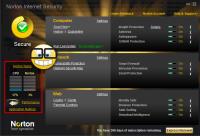 The instant I removed Bit Defender's application and installed NIS, it was like I had a new computer. One of my primary complaints with all of the applications I tried is that they got in the way of my using the computer. It wasn't solely their fault, but every other application severely exacerbated the problem.
The instant I removed Bit Defender's application and installed NIS, it was like I had a new computer. One of my primary complaints with all of the applications I tried is that they got in the way of my using the computer. It wasn't solely their fault, but every other application severely exacerbated the problem.
Note the tiny load NIS places on the system (at right).
But $70 per year? Doesn't that seem a bit steep? For a single computer, yes. If you have just one computer, you can license a single-user version for less than $30. The $70 fee covers 3 computers and that's what I have: A desktop and two notebooks. $23 per computer is pretty reasonable.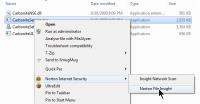
Perhaps the most important new feature is what Symantec calls "Quorum". It's the protective engine that examines files without seriously affecting system performance. Earlier versions of the application protected the computer, but also rendered it virtually unusable. Quorum changes all that by cataloging "trusted" files. Quorum looks at the files on your computer and examines what they do on the computer and when connecting to the Internet and it compares this behavior to the behavior reported by NIS on millions of other computers.
To see Quorum's report on a file, simply right-click the file from the Windows Explorer and select Norton File Insight.
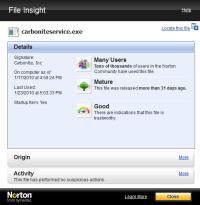 Yes, you can opt out of this system, but why would you?
Yes, you can opt out of this system, but why would you?
Starting with Internet Security 2009, Symantec's advertisements admitted that earlier versions of the application had speed problems. One doesn't always place one's full trust in a company's advertising platform, after all. But they're telling the truth. NIS increases boot time slightly, but no more than any of the other applications I looked at.
Opening websites is just as fast with NIS installed or not. That's particularly impressive. I didn't see much difference when it came to manipulating files from the Windows Explorer or when compressing or decompressing files. In other words, it would seem that Norton's reputation as a resource hog is no longer deserved.
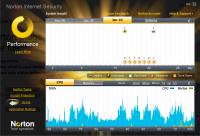 In fact, NIS 2010 even includes information about how many system resources the application is using. So they paid attention to the complaints and did something about it. Now Norton provides the same good security it's always been known for without turning your computer into a pet rock.
In fact, NIS 2010 even includes information about how many system resources the application is using. So they paid attention to the complaints and did something about it. Now Norton provides the same good security it's always been known for without turning your computer into a pet rock.
Symantec is the biggest dog on the block and the company knows about millions of files and what they're expected to do. That's what Quorum is based on. If a file is on a lot of computers and is behaving normally, the application considers it to be trusted.
This is particularly clever because most current threats constantly mutate to avoid signature-based detection. That works in Quorum's (and your) favor and it mitigates threats from these kinds of malware.
NIS examines all POP3 e-mail for spam and viruses. Yes, this does slow e-mail downloads a bit, but not so much as with competing applications.
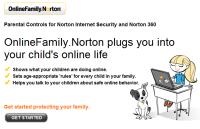 I didn't test NIS's parental controls, in part because my youngest daughter is is 25 years old and in part because I feel the entire concept is silly. But from what I've seen, the parental controls in this version are good.
I didn't test NIS's parental controls, in part because my youngest daughter is is 25 years old and in part because I feel the entire concept is silly. But from what I've seen, the parental controls in this version are good.
By default, Norton installs a toolbar in Internet Explorer (why are you still using this?) and Firefox, but not in other browsers such as Chrome, Opera, or Safari. It adds icons to search results so that you can see whether the URL is safe, suspicious, or dangerous. Or you can use the optional Norton Safe Search, which highlights search results in yellow (suspicious) or red (dangerous).
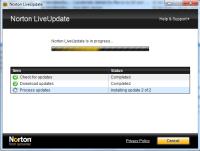 The suite's Identity Safe stores and manages passwords and other information in the form of "identity cards". This doesn't have all the features of an application such as KeePass, but it's available at all times from either of the two primary browsers. I consider this a worthwhile feature.
The suite's Identity Safe stores and manages passwords and other information in the form of "identity cards". This doesn't have all the features of an application such as KeePass, but it's available at all times from either of the two primary browsers. I consider this a worthwhile feature.
After a long and frustrating search, this is the application I have decided to pay for.
How Good is Support?
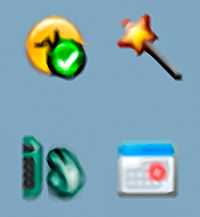 In my opinion, not very good. The built-in documentation is sorely lacking and here's an example: I noticed that the icon in the Tray (Notification Area) is normally round with a green checkmark in a circle. I took this to mean everything is OK. But sometimes it mutates into a shape that reminds me of a pineapple. The checkmark remains. What does this mean?
In my opinion, not very good. The built-in documentation is sorely lacking and here's an example: I noticed that the icon in the Tray (Notification Area) is normally round with a green checkmark in a circle. I took this to mean everything is OK. But sometimes it mutates into a shape that reminds me of a pineapple. The checkmark remains. What does this mean?
The normal icon is the top-left image in the display at the right (larger than life size). To see the other version of the icon, hover your mouse over the image.
The icons should be illustrated in the online documentation. They're not.
The icons should be illustrated on the Symantec website. I couldn't find any illustrations of the icons.
From the support site, I sent an e-mail question to support explaining the appearance. The first response seemed to think that I was seeing an icon that would indicate NIS 2010 had been turned off. I explained again that NIS was on and OK, but that the icon looked like a pineapple. The second response from support described the standard icon, the icon that indicates attention is needed, and the icon the shows NIS is out of service. I explained once again that I was asking about a pineapple-shaped icon and sent a screen shot showing the icon in question. The support staff cannot receive images (a security issue the third support response said) and I was told to start an online chat session.
After waiting nearly 15 minutes for a technician, I was welcomed to the chat session, which started the same way the e-mail session had gone. So I asked if they have a way to view my screen. They use LogMeIn-Rescue, so the technician looked at my screen.
"The icon is normal," was the diagnosis, and it was. The icon in the Tray was the standard round icon, but I had a screen capture. Look at this, I said as I directed the technician's attention to the screen capture that I opened. (I have obscured the technician's name.)
5:18 PM Xxxxxxx X: That is not the Norton icon it is a screen shot
5:18 PM Xxxxxxx X: And it has nothing to do with Norton
5:18 PM Xxxxxxx X: Pc is safe
5:20 PM : ~Mr. William Blinn :: It __IS__ the Norton icon. I understand that the PC is safe. The green check is present. What I'm trying to find out is why the icon sometimes takes on this shape. I understand that this is an odd question, but I am reviewing this application for a published review.
5:20 PM Xxxxxxx X: Okay
5:22 PM Xxxxxxx X: I have to consult my supervisor.
Apparently the supervisor knew a bit more about how the program works.
5:24 PM Xxxxxxx X: It happens when you early load is on and the PC is turned to silent mode
5:25 PM : ~Mr. William Blinn :: I have never used Silent Mode, although I read about it in the docs. Early load, I'm not sure. But if it's not the default, I haven't yet used it either.
5:26 PM Xxxxxxx X: Yes but when ever system is left idle it goes to that mode and it is the feature of Norton
5:27 PM : ~Mr. William Blinn :: OK. And it doesn't revert to the normal icon until after a reboot?
5:28 PM Xxxxxxx X: Yes
That seemed absurd, but I let it go. If an application switches modes because of activity or lack of activity, it should switch back as the circumstances change. Still, once I'm in "pineapple mode", NIS stays in that mode until I reboot or until I open the NIS settings panel and change some settings.
5:36 PM : ~Mr. William Blinn :: Thank you. Sorry to be a pain, but I know some reader is going to expect me to know the answer to this question.
5:37 PM Xxxxxxx X: William I will surely escalate this to my seniors.
Two days later, I received a survey from Symantec. Part of my response is shown here:
"I am reviewing NIS 2010 for publication. I wondered why the Tray (Notification Area) icon was sometimes round and sometimes looked like a pineapple. I couldn't get an answer by e-mail (3 tries). When I started a chat session and your technician logged on to my system using LogMeIn Rescue, I showed the technician a screen shot of the 'pineapple' icon and was told this isn't the NIS icon. Later, the technician checked with a supervisor and found out that it is indeed one of the shapes the icon takes and that it represents a 'silent' state that NIS switches into for some reason or another (not known to the technician). This is a question that should have been answered by product documentation or after the first e-mail or within the first 5 minutes of a chat session. The chat session lasted well over 30 minutes, which was an absurd waste of your technician's time and mine."
I had started waiting for a technician around 4:45 and the chat session started shortly before 5. The screen-sharing session, according to the timestamps, began at 5:12 and terminated at 5:39. Obtaining a partial answer to what should have been a very simple question stretched over more than a week, 3 e-mail exchanges, and nearly an hour of online support time!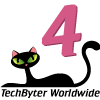
Bottom Line: Norton Internet Security hits a home run.
After a long dry spell, Symantec has what I consider to be the definitive protective application. Unlike all of the other applications I looked at, NIS didn't bog the system down. The system settings aren't as complete as I'd like, but superior protection combined with limited use of system resources seems like a big winner to me.
For more information, visit the Norton website.
Out! Out! Damn Spot!
Have you ever tried to remove a program using the application's built-in uninstaller or the Windows Add and Remove Programs feature? Most of the time, it works; sometimes it fails. Even when it succeeds, though, you'll often be left with some pieces of the program in a directory or in the Registry. But there's a better way and it doesn't cost anything.
The Revo Uninstaller is the little brother of Revo Uninstaller Pro. After you install Revo Uninstaller, the program will show you icons of all programs installed on your machine. You can change the view to a standard list or details option.
When you have Windows uninstall a program, you'll usually still have "leftovers". Revo's developer says the application will find those bits and remove them. How true is this claim?
To find out, I installed the free version of Revo and looked for something to remove. That turned out to be easy: The Ask Toolbar had been installed and I didn't want it. To be clear, there's nothing wrong with the Ask Toolbar except that it was installed without my knowledge or permission.
Several applications do this. In this case, I believe it was Nero that did it. I don't use it. It takes up screen real estate. And it was installed surreptitiously. Three strikes, so it's out.
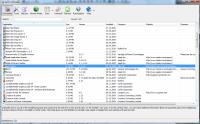 Revo Uninstaller found it as 1 of 123 applications that had been installed. I selected it from the list and clicked Uninstall. A normal uninstall will remove some files from Program Files folder and will remove some Registry entries.
Revo Uninstaller found it as 1 of 123 applications that had been installed. I selected it from the list and clicked Uninstall. A normal uninstall will remove some files from Program Files folder and will remove some Registry entries.
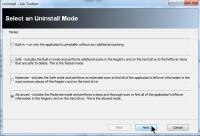 The default was the Moderate mode, but I selected Advanced to make sure that all possible remnants would be removed, including directories and Registry entries.
The default was the Moderate mode, but I selected Advanced to make sure that all possible remnants would be removed, including directories and Registry entries.
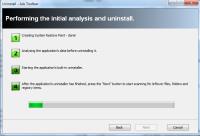 Revo created a System Restore Point. This is wise. If something goes wrong, you can restore the system to the point just before you ran the Revo Uninstaller. It then examined the application and launched the application's uninstaller. In this case, the Ask uninstaller failed and Revo continued.
Revo created a System Restore Point. This is wise. If something goes wrong, you can restore the system to the point just before you ran the Revo Uninstaller. It then examined the application and launched the application's uninstaller. In this case, the Ask uninstaller failed and Revo continued.
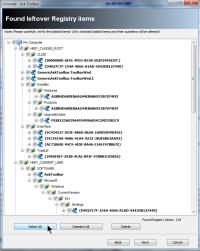 Then Revo examined the Registry. The Ask Toolbar had an absurd 219 Registry entries. I told the application to remove all of them.
Then Revo examined the Registry. The Ask Toolbar had an absurd 219 Registry entries. I told the application to remove all of them.
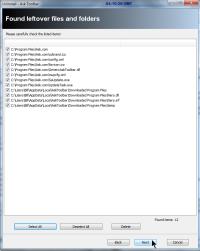 After deleting the unnecessary Registry keys, Revo showed me a list of directories with left-over program components. I told Revo to remove them, too.
After deleting the unnecessary Registry keys, Revo showed me a list of directories with left-over program components. I told Revo to remove them, too.
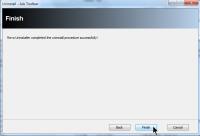 A few moments later, the process was complete and the Ask Toolbar no longer took up space in my Web browser.
A few moments later, the process was complete and the Ask Toolbar no longer took up space in my Web browser.
Revo also includes an Autorun Manager that lets you specify which applications should start when Windows starts. Additionally, Revo provides quick access to a number of Windows tools. And you'll find several other cleaning tools that may or may not be useful. I'm not a big fan of cleaner tools because they often clean too much.
In Hunter mode, the Revo Uninstaller minimizes to Task Bar so that you can remove an application from the Desktop. Point to an icon and choose to uninstall, disable process in startup list, kill its process, open the containing folder, perform a Google search, or examine its properties. This isn't a useful feature for me because I keep no applications on the Desktop.
 Bottom Line: Quick and free way to take out the trash.
Bottom Line: Quick and free way to take out the trash.
Revo Uninstaller carefully removes a program by using the application's uninstaller, but then it cleans up any left over Registry entries or directories. The fact that it's free makes it even better.
For more information, visit the Revo website.
IPad: That's the Best Name They Could Think Of?
What's wrong in Cupertino? Instead of the usual adulation (although there's plenty of that), Apple's latest gadget is being met with abuse, satire, and derision. The Ipad will probably fly off store shelves, but I have to wonder what engineering was thinking of when they decided to make a computer-size phone in the shape of a tablet computer and what marketing what thinking when they came up with the name.
The name has 2 problems. First, it's just too cute. The Ipad looks like an overgrown Ipod and Apple really didn't need the cutesy name to make that point. It's painfully obvious. The second thing wrong with the name is that Mad TV came up with the name for a fake product years ago. It was a product that women could wear internally. Did anyone at Apple perform a Google search before choosing this name?
As for engineering, who do they think will want an Ipod that's the size of a notebook and doesn't do anything more than an Ipod does? The Ipad runs on an operating system that's far closer to the operating system used on the Iphone and Ipod than OS X, the operating system that powers Apple's computers. That means the applications you would want to run on the Ipad (were it really a computer) won't run because the Ipad is actually just a overgrown Ipod.
What a disappointment.
The Onion (a satirical "news" outlet) said that Apple CEO Steve Jobs "stayed up all night Tuesday in a desperate effort to design Apple's new tablet computer."
You can see the Mad TV clip (about 90 seconds) here. It's more than a little suggestive, so don't click the link if you'll be offended.
And graphic artists, the very people who are key to Apple's continued success, seem to be poking fun at the Ipad and even at Steve Jobs.
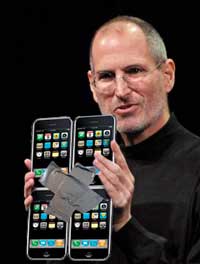 Source: http://i.imgur.com/oRffH.jpg
Source: http://i.imgur.com/oRffH.jpg
Click a small image for a larger view. Click the larger view to close it.
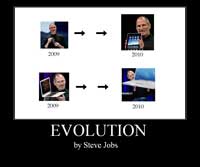 Source: http://i.imgur.com/wApCi.png
Source: http://i.imgur.com/wApCi.png
As a graphic designer I'm related to said, "How did they not see that coming?"
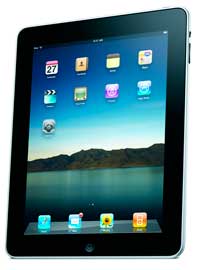 Here's the Real Ipad
Here's the Real Ipad
According to Apple, the Ipad is "a revolutionary device for browsing the Web, reading and sending e-mail, enjoying photos, watching videos, listening to music, playing games, reading e-books and much more." In other words, it's an overgrown Ipod.
The Ipad is half an inch thick and weighs less than 2 pounds. The most basic model costs $500 and will be available in late March.
For more details, see Apple's website.
Short Circuits
Keep Your Hands Off Firefox, Microsoft!
They did it again! Microsoft was criticized, and rightly so, about a year ago when it started installing a Net Framework addition in Mozilla Firefox without asking for permission to do so. To make things worse, the installation was botched so that removing it wasn't particularly easy. I've disabled it. I've uninstalled it. And it keeps coming back! Stop it, Microsoft!
I have nothing in particular against Net Framework. After all, it's the underlying application for a system we use at the office to allow secure VPN-like connections across the public Internet. What I do resent just a bit is Microsoft's decision that my copy of Firefox should have a Net Framework extension whether I want it or not.
The latest version was released in mid December, 2009.
Listen, Microsoft: I don't need Net Framework in Firefox. I have quite enough extensions as it is and I wish you'd keep your fingers out of my browser.
If you have any application that uses Microsoft Net Framework components installed on your computer, Microsoft apparently thinks it's OK to shoehorn the Microsoft Net Framework Assistant into Firefox.
In fairness to Microsoft, though, that company may not be the sole culprit. If you install an application that relies on Net Framework, that application may install, without your permission, the Net Framework Assistant in Firefox.
So allow me to revise my previous statement:
Listen, developers: If you want to install something on my computer—anything more than what I have explicitly given you permission to install—ask me first.
Vista Fades as a Bad Fiscal Memory
Microsoft's earnings are up and not just a little. The company says earnings increased 60% in the most recent quarter, compared to the same period a year ago. Apparently holiday shopping and upgrade fever helped out now that Vista is finally out of the picture.
Net income in the 4th quarter was $6.7 billion.
Much of the growth was in the Windows division, where revenue was up 70%. Sales of Office products were flat, though, probably because people are waiting for the new version of Office. Office 10 is in beta now and will begin shipping later this year.

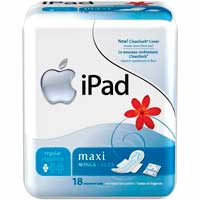

 The author's image: It's that photo over at the right. This explains why TechByter Worldwide was never on television, doesn't it?
The author's image: It's that photo over at the right. This explains why TechByter Worldwide was never on television, doesn't it?
